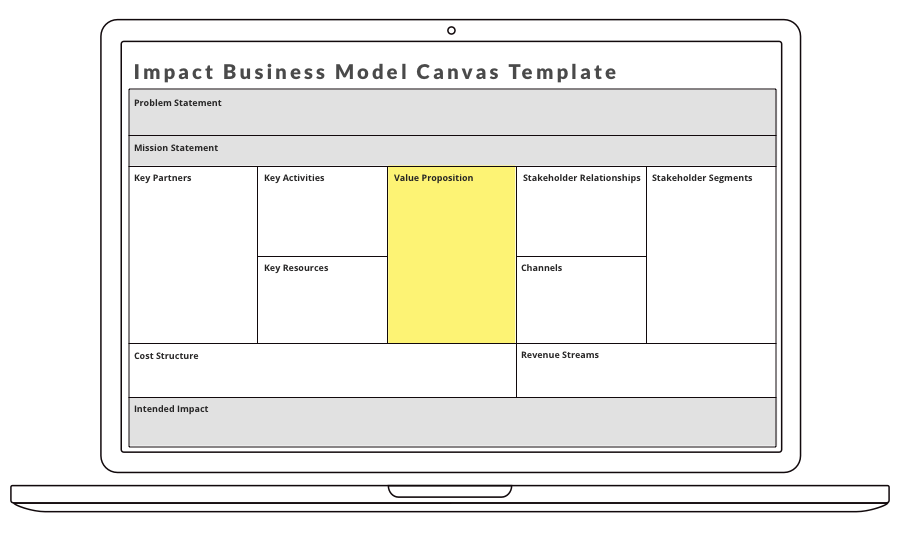
4 | Value Proposition

Value Proposition highlighted on the canvas
A value proposition creates value for a customer segment through a distinct mix of elements catering to that segment’s needs. Elements from the following non-exhaustive list can contribute to customer value creation: newness, performance, customization, getting the job done, design, brand/status, price, cost reduction, risk reduction, accessibility, convenience, and usability.
A social enterprise often has two value propositions - the impact value proposition (the social value you are seeking to deliver, and what makes it attractive to customers) and the commercial value proposition (the goods and services you are producing and selling, and what makes these attractive to customers). They are ultimately linked, but separating them out for discussion can help us to see how each relates to our different customer segments... [continued below]
Value proposition:
d.light sells solar energy solutions to populations without electricity in 60+ nations. See project description and its Impact BMC
Value proposition:
Equal Opportunity Schools helps minority and low-income high school students succeed in AP and IB courses. See project description and its Impact BMC
Businesses where the social and commercial value align or reinforce each other are good cases for for-profit social enterprise: optimizing for product/market fit will prepare the organization to draw revenue from sales. However, the intended social value cannot always be generated as an added bonus to a commercial value proposition. This is the case when beneficiaries of the social value can’t support its full cost. Social benefit organizations have adopted one or more of the following approaches.
Design for extreme affordability. For example, Earthenable delivers beautiful low cost flooring (commercial proposition) which lower health hazards (social impact value proposition) in Rwandan mud huts.
Explore differentiating product/service for those willing to pay more, so you can use the additional revenue to subsidize value for those with limited ability to pay. For example Tom’s Shoes 1 for 1 model enables the company to give away a pair of shoes for every pair sold. Risks inherent to such models include losing focus on the best service to the targeted disadvantaged segment in the process of adapting activities to a different customer base. Focusing on optimizing the social value proposition is often the surest way to deliver it. For example: d.light, a producer of solar lighting designed low cost lamps for the bottom of the pyramid but decided against developing a camping light line of products which might have been a source of subsidy to donate lamps to those who can’t afford them. Those lamps might have ended up inadequate for the needs of these people.
Finally, many social benefit organizations disconnect commercial from social value proposition. For example, Assylum Access works to protect refugee rights in host countries. With no right to work, refugees don’t earn a living to buy this value proposition from the organization. Assylum Access’ commercial value proposition lies in its ability to demonstrate its impact model and sell it for replication to organizations around the world.
Optimizing one’s product/impact fit in addition to or in replacement of one’s product/market fit prepares the organization to monetize impact as a way to supplement revenue from sales.
For most businesses social impact is not the point of the proposed value proposition. This doesn’t mean that these organizations cannot achieve significant impact along their value chain by carefully crafting their interactions with stakeholders at every level of their operations.